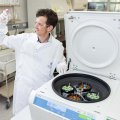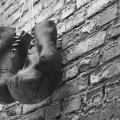A geothermal energy researcher from the University of Queensland (UQ) has found evidence of a major asteroid impact that occurred more than 300 million years ago in the South Australian outback.
The asteroid, which produced a shock zone at least 80km wide, could be the second-largest asteroid ever found in Australia.
UQ’s Queensland Geothermal Energy Centre of Excellence researcher, Dr Tonguç Uysal, discovered the asteroid impact during his studies of the Cooper Basin, which is a large geothermal energy resource being developed in Australia on the border between Queensland and South Australia.
“I noticed that the quartz grains in the rock had unusual planar deformation features that indicated either it had been exposed to extreme tectonic pressure or a large asteroid impact,” Dr Uysal said.
The rock deformations were confirmed as being the result of an asteroid impact through microscopic examination of the quartz crystals and further laboratory tests conducted by Dr Andrew Glikson, from the Australian National University.
“The results suggest that either a very large asteroid or a cluster of asteroids landed, but we need to do further testing to verify this,” Dr Uysal said.
“The impact of the asteroid triggered a huge explosion and caused the ground water to boil and induce chemical and mineralogy changes in the surrounding rocks.
“This may have resulted in the reconcentration of various heat-producing elements which has made the Cooper Basin such a rich source of geothermal energy today,” he said.
The land surface that the asteroid hit is now buried under layers of sedimentary rock and Dr Uysal thinks the original crater most likely eroded away.
Dr Uysal said further studies of rock samples from drill holes in the Cooper Basin were required to more accurately map the extent of the impact area, which is estimated to be at least 80km wide.
Further research will also allow estimation of the size of the asteroid that caused the impact.
Australia’s largest recorded asteroid impact is at Woodleigh, east of Shark Bay in Western Australia and according to Dr Glikson, the Woodleigh impact structure (120 km in diameter) was produced by an asteroid six to 12 kilometres across, about 360 million years ago.
Dr Uysal and Dr Glikson will present their findings at the Australian Geothermal Energy Conference in Adelaide, 16-19 November 2010.
The Queensland Government has invested $15 million in the Queensland Geothermal Energy Centre of Excellence, and the Minister for Natural Resources, Mines and Energy, Mr Stephen Robertson congratulated Dr Uysal and Dr Glikson on their discovery.
“The Government has funded the Centre to learn more about the potential of hot dry rocks as a clean energy source and to be able to find evidence of a major asteroid impact during their geothermal research is a bonus discovery,” Mr Robertson said.
To read more about their research, see their conference paper.
Media: Dr Tonguç Uysal (07 3365 2819 or 0421 041 738, t.uysal@uq.edu.au), Dr Andrew Glikson (0439 085 833 or 02 6296 3853, andrew.glikson@anu.edu.au) or Ms Izzy Koh, UQ’s Faculty of Engineering, Architecture and Information Technology (07 3346 7696 or i.koh@uq.edu.au)



